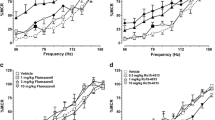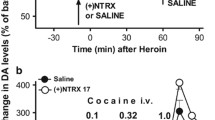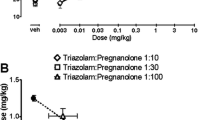Abstract
Previous results in our laboratory have shown that both chlordiazepoxide and ethanol will release punished responding in a rat operant conflict test using incremental shock. In the present study, a benzodiazepine antagonist and a benzodiazepine inverse agonist were used to explore the neurochemical basis for this behavioral action. N-methyl-β-carboline-3-carboxamide (FG 7142) at high doses (20 and 40 mg/kg) produced suppression of both punished and unpunished responding, and reversed the release of punished responding produced by both chlordiazepoxide and ethanol, but only at doses that produced an effect on its own. FG 7142 thus acted to oppose the actions of both ethanol and benzodiazepines but in an additive, not interactive, manner. In contrast, RO 15-1788 produced no changes when injected by itself in doses as high as 12 mg/kg and reversed chlordiazepoxide-induced but not ethanol-induced release of punished responding. RO 15-1788 also reversed the decrease in punished responding produced by FG 7142. Results suggest that ethanol does not interact directly with the benzodiazepine binding sites on the GABA/benzodiazepine ionophore complex to produce its anxiolytic action.
Similar content being viewed by others
References
Aston-Jones S, Aston-Jones G, Koob GF (1984) Cocaine antagonizes anxiolytic effects of ethanol. Psychopharmacology 84:28–31
Barrett JE, Brady LS, Wilkin JM (1985a) Behavioral studies with anxiolytic drugs. I. Interactions of the benzodiazepine antagonist RO 15–1788 with chlordiazepoxide, pentobarbital and ethanol. J Pharmacol Exp Ther 233:554–559
Barrett JE, Brady LS, Wilkin JM, Cook JM, Larscheid P (1985b) Interactions between the benzodiazepine receptor antagonist RO 15–1788 (Flumazepil) and the inverse agonist B-CCE: behavioral studies with squirrel monkeys. Life Sci 36:1407–1414
Barry H (1977) Alcohol. In: Pradhan SN, Dutta SM (eds) Drug abuse, clinical and basic aspects. CV Mosby Co., St. Louis
Breese GR, Frye GD, Vogel RA, Koepke KM, Mueller RA (1983) Comparisons of behavioral and biochemical effects of ethanol and chlordiazepoxide. In: Pohorecky LA, Brick J (eds) Stress and alcohol use. Elsevier, Amsterdam, pp 261–276
Cook L, Sepinwall J (1975) Behavioral analysis of the effects and mechanisms of action of benzodiazepines. In: Costa E, Greengard P (eds) Mechanism of action of benzodiazepines, Raven Press, New York, pp 1–28
Corda MG, Blaker WD, Mendelson WB, Guidotti A, Costa E (1983) B-Carbolines enhance shock induced suppression of drinking in rats. Proc Natl Acad Sci USA 80:2072–2076
Crawley JN, Skolnick PM, Paul SM (1984) Absence of intrinsic antagonist actions of benzodiazepine antagonists on an exploratory model of anxiety in the mouse. Neuropharmacology 23:531–537
Dantzer R, Perio A (1982) Behavioural evidence for partial agonist properties of RO 15–1788, a benzodiazepine receptor antagonist. Eur J Pharmacol 81:655–658
Dorow R, Horowski R, Paschelke G, Amin M, Braestrup C (1983) Severe anxiety induced by FG 7142, a beta-carboline ligand for benzodiazepine receptors. Lancet 2:98–99
File SE, Lister RG, Nutt DJ (1982a) The anxiogenic action of benzodiazepine antagonists. Neuropharmacology 21:1033–1037
File SE, Lister RG, Nutt DJ (1982b) Intrinsic actions of benzodiazepine antagonists. Neurosci Lett 32:165–168
Frye GD, Breese GR (1982) GABAergic modulation of ethanol-induced motor impairment. J Pharmacol Exp Ther 23:750–756
Geller I, Seifter J (1960) The effects of meprobamate, barbiturates, d-amphetamine, and promazine on experimentally induced conflict in the rat. Psychopharmacology 1:482–492
Haefely W (1983) Antagonists of benzodiazepines: Functional aspects. In: Biggio G, Costa E (eds) Benzodiazepine recognition site ligands: Biochemistry and Pharmacology, Raven Press, New York, pp 73–93
Hunkeler W, Mohler H, Pieri L, Polc P, Bonetti EP, Cumin R, Schaffner R, Haefely W (1981) Selective antagonists of benzodiazepines. Nature 290:514–516
Koob GF, Thatcher-Britton K (1985) The role of the GABA/benzodiazepine complex in the anxiolytic actions of ethanol. Alcoholism 9:204
Koob GF, Thatcher-Britton K, Britton DR, Roberts DCS, Bloom FE (1984) Destruction of the locus coeruleus or the dorsal NE bundle does not alter the release of punished responding by ethanol and chlordiazepoxide. Physiol Behav 33:479–485
Liljequist S, Engel J (1982) Effects of GABAergic agonists and antagonists on various ethanol induced behavioral changes. Psychopharmacology 78:71–75
Liljequist S, Engel JA (1984) The effects of GABA and benzodiazepine receptor antagonists on the anti-conflict actions of diazepam or ethanol. Pharmacol Biochem Behav 21:521–525
Lloyd KG, Bovier P, Broekkamp CL, Worms P (1981) Reversal of the anti-aversive and anti-convulsant actions of diazepam, but not of progabide by a selective antagonist of benzodiazepine receptors. Eur J Pharmacol 75:77–78
Patel JB, Martin C, Malik JB (1983) Differential antagonism of the anti-conflict effects of typical and atypical anxiolytics. Eur J Pharmacol 86:295–298
Petersen EN, Paschelke G, Kehr W, Nielsen M, Braestrup C (1982) Does the reversal of the anti-conflict effect of phenobarbital by B-CCE and FG 7142 indicate benzodiazepine receptor-mediated anxiogenic properties? Eur J Pharmacol 82:217–221
Petersen EN, Jensen LH, Honore' T, Braestrup L (1983) Differential pharmacological effects of benzodiazepine receptor inverse agonists. In: Biggio G, Costa E (eds) Benzodiazepine recognition site ligands: Biochemistry and pharmacology, Raven Press, New York, pp 57–64
Pollard GT, Howard JL (1979) The Geller-Seifter conflict paradigm with incremental shock. Psychopharmacology 62:117–121
Prado de Carvalho L, Grecksch G, Chapouthier G, Rossier J (1983) Anxiogenic and non-anxiogenic benzodiazepine antagonists. Nature 301:64–66
Thatcher-Britton K, Morgan J, Rivier J, Vale W, Koob GF (1985) Chlordiazepoxide attenuates CRF-induced response suppression in the conflict test. Psychopharmacology 86:170–174
Ticku MK, Burch T (1980) Alterations in GABA receptor sensitivity following acute and chronic ethanol treatment. J Neurochem 34:417–423
Ticku MK, Burch TP, Davis WC (1983) The interactions of ethanol with the benzodiazepine-GABA receptor-ionophore complex. Pharmacol Biochem Behav, 18, Suppl 1:15–18
Vellucci SV, Webster RA (1982) Antagonism of the anti-conflict effects of chlordiazepoxide by beta-carboline carboxylic acid ethyl ester, RO 15–1788 and ACTH 4–10. Psychopharmacology 78:256–260
Vellucci SV, Webster RA (1983) Is RO 15–1788 a partial agonist at benzodiazepine receptors? Eur J Pharmacol 90:263–268
Author information
Authors and Affiliations
Rights and permissions
About this article
Cite this article
Koob, G.F., Braestrup, C. & Britton, K.T. The effects of FG 7142 and RO 15-1788 on the release of punished responding produced by chlordiazepoxide and ethanol in the rat. Psychopharmacology 90, 173–178 (1986). https://doi.org/10.1007/BF00181236
Received:
Revised:
Issue Date:
DOI: https://doi.org/10.1007/BF00181236




